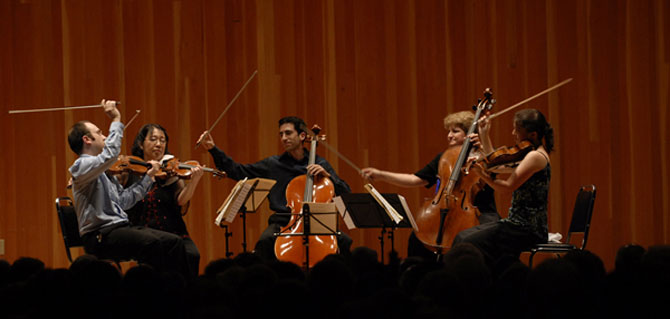Return of the Marlboro Men (and Women)
by Jan Jezioro

Musicians from Marlboro perform Boccherini and Schubert String Quintets
The Buffalo Chamber Music Society winds up its 86th annual season on Tuesday, May 11 at 8pm, when the Musicians from Marlboro make their fourth consecutive yearly appearance on the stage of the Mary Seaton Room in Kleinhans Music Hall as the final event in their eight-city spring tour. Of course, the musicians performing at this year’s concert are not necessarily the same musician who performed here in any of the three previous seasons. The touring Musicians from Marlboro are all young performers who have been a part of the summer Marlboro Music Festival in Vermont. Previous rosters of the group have included literally dozens of young performers who went on to careers in classical music at the very highest levels; the performers on Tuesday’s program are Hiroko Yajima and David Bowlin (violins), Marcy Rosen and Amir Eldan (cellos), and Rebecca Albers (viola).
The String Quintet in F Major, Op. 20, No.3 by Luigi Boccherini (1743-1805) marks only the second time that a work by the prolific Italian composer will appear on a BCMS program. A leading founder of modern virtuoso cello technique, Boccherini became one of the greatest cellists of the latter half of the 18th century. After studying in Italy, Boccherini moved to France, where, in Paris, he met the Roman soprano Clementina Pelliccia. When Pelliccia, along with her older sister, joined an opera company in Spain, Boccherini followed her in 1768 to the country where he would compose almost 600 works and spend the last 37 years of his life, finding employment with the royal court. It’s small wonder that Boccherini ended up in Spain. The Venetian author and adventurer Casanova, who might be regarded as something of an expert in the matter, wrote in his famous memoirs that he attended a dinner with the Pelliccia sisters and the composer, a year before Boccherini married Clementina, who he describes as “really nice, not to say beautiful.”
Boccherini composed an astonishing 120 string quintets featuring two cellos, but for the first half of the 20th century, only his String Quintet Op. 30, No. 6, “Night Music of the Streets of Madrid,” a highly colorful programmatic work, was generally performed; ironically the composer is on record as telling his publisher, “The piece is absolutely useless, even ridiculous, outside Spain, because the audience cannot hope to understand its significance, nor the performers to play it as it should be played.”
Boccherini had composed his string quintets for two violins, two cellos, and viola. When Mozart composed his six masterpieces in the genre, he wrote for two violas and one cello, and this became the standard instrumentation for the string quintet. When Schubert composed his String Quintet in C Major, Op. 163, D. 956 in 1828, however, he used the same instrumentation that Boccherini had employed. Written during the final months of his brief life, the String Quintet in C Major is Schubert’s finest chamber music work, and generally acknowledged to be one of the greatest works of the entire chamber music repertoire. Local chamber music aficionados will have the rare opportunity to hear this masterpiece twice in one month; in April, violinist Charles Haupt led a convincing performance of the work as a part of A Musical Feast, his chamber music series at the Burchfield Penney Art Center.
Igor Stravinsky’s brief 1914 work, the quirky Three Pieces for String Quartet, might more accurately be described as being three pieces for four strings, since the work is very different from any string quartet composed before it. The first piece finds each instrument obstinately going its own way, oblivious to the others. The very idiosyncratic second piece is a highly colorful burlesque, while the third blends the instruments in a somber homophony of an almost liturgical character that’s almost a polar opposite of the first piece.
Tickets are $20 general admission, $19 for students. For more information, visit www.bflochambermusic.org.
blog comments powered by Disqus|
Issue Navigation> Issue Index > v9n18 (week of Thursday, May 6) > Return of the Marlboro Men (and Women) This Week's Issue • Artvoice Daily • Artvoice TV • Events Calendar • Classifieds |









 Current Issue
Current Issue